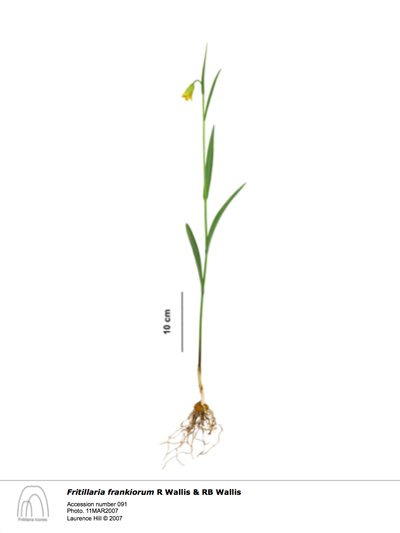Fritillaria frankiorum
In April 1993, we were investigating bulbous plants in the Turkish vilayet of Hatay and on making enquiries of a local farmer about "ters lale" (literally: hanging lilies), were shown a population of tall green fritillaries. The population comprised perhaps 100 flowering individuals, and countless bulblet leaves, growing in very moist soil in cultivated fields. The very stout stigma and few, narrow, leaves per stem clearly placed this species close to F. assyriaca Baker and F. uva-vulpis Rix (Rix 1974). Two subsequent visits to adjacent Syria resulted in the identification of two further sites. In all cases the plants were weeds of cultivation and grew in very moist soil and in one place the fields were still flooded from winter rains. These plants were in full flower in spite of the fact that the soil was inundated to a depth of about 10 cm with the stems emerging like pond marginals. Plants from all three colonies appear identical, the flowers opening green and fading to brown as they age.
We first reported the occurrence of this plant in 1997, and expressed the opinion then that it was a giant variant of F. assyriaca. Careful morphological examination of living specimens of both this and typical F. assyriaca from four different locations in Turkey as well as cultivated material of F. uva-vulpis has now led us to the conclusion that this is a heretofore undescribed species.
We have named this new species Fritillaria frankorum to honour Ronald and Erna Frank who were with us on each of the above expeditions and without whose insistence we would probably never have asked the farmer in the first instance. We now understand that following the strict rules on botanical nomenclature, this should have been F. frankiorum.
This plant had actually been collected before and specimens reside in the herbarium in Istanbul, Geneva and Kew but in none of the cases was it recognised as being a new taxon
Fritillaria frankiorum Wallis & Wallis. Plantsman New Series 2(1) 15 – 16 (2003) as ‘frankorum’.
Synonym: F. pinardii sensu Mouterde in Nouvelle Flore du Liban et de la Syrie, 1: 234 (1966).
Description
Bulb globose with numerous bulblets and stolons. Stem 25 - 45 cm above bulb. Leaves 4 - 6 all alternate, the lowest 6 - 11 x 1 cm, linear flat or slightly canaliculate, the uppermost, a single bract leaf 3.5 - 6.5 x 0.3 - 0.4 cm. all glaucescent. Leaves on unflowered bulbs shiny green with no trace of glaucescence 7 x 2.5 cm. Flowers 1 (-2) conical, perianth segments rhomboid, green inside and out, fading to purplish brown sometimes with a thin purplish edge, ciliate at the tip. Outer segments 21 - 24 x 7.5 - 8 mm, inner segments 21 - 24 x 9.5 mm. Nectaries lanceolate, indistinct green 4 x 2 mm, 0.5 mm above tepal base. Filaments 7.5 mm, papillose at distal end, markedly dilated near apex to 1.5 mm narrowing to a point where the anther is attached. Anthers yellow 6 - 7 mm, distinctly mucronate at tip. Style 9 x 3 mm, stout, clavate, papillose. Grows in agricultural fields which are wet or even inundated in winter, Turkey, southern Hatay and adjacent NW Syria.
Chromosome Number: 2n = 24
Habitat & Distribution: TURKEY: N of Yayladaği, Hatay, Turkey. Cultivated fields, Wallis 93.16 (9th April 1993);
SYRIA: East of Kassab, North Syria. Cultivated, partly flooded fields and other disturbed ground at 700 m, Wallis 96.11 (29th March 1996); North of Rabi'ah, North Syria Cultivated fields at 600 m, Wallis 96.16 (30th March 1996).
Flowering period: March-April
Type: Type: Turkey, Hatay, N of Yayladaği, weed of cultivated fields in seasonally moist or wet soils, 9th April 1993 (WIS).
Cultivation: We have grown this plant for many years in moist soil in our cold greenhouse. It flowers most years and produces huge quantities of bulbils. Since is clearly protected from direct sun by crops (either wheat or tobacco) in the summer and these are irrigated, it probably does not appreciate being too hot or dry in the summer.
Rannveig Wallis & Robert B Wallis ©2008
![]()



